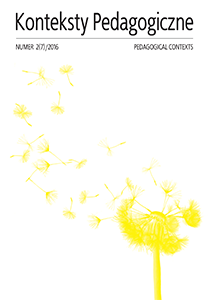Abstract
The paper presents the problem of communicating with a child with autism spectrum disorders. It describes the skills and dysfunctions of communication and indicates the need for communication which is augmentative and alternative for working with an autistic child. Amongst the many methods, AAC PECS method was chosen. In case of children with autism spectrum this system develops communication skills and it enables to achieve great successes.
References
Błeszyński J.J., Komunikacja osób ze spektrum autyzmu – w poszukiwaniu najlepszych rozwiązań, [w:] Autyzm i AAC. Alternatywne i wspomagające sposoby porozumiewania się w edukacji osób z autyzmem, red. B.B. Kaczmarek, A. Wojciechowska, Kraków 2015.
BobkowiczLewartowska L., Autyzm dziecięcy – zagadnienia diagnozy i terapii, Kraków 2005.
Frith U., Autyzm.Wyjaśnienie tajemnicy, przeł. M. Hernik, G. Krajewski, Gdańsk 2008.
Frost L., Bondy A., The PictureExchange Communication System, przeł. M. Kaźmierczak, Gorzów Wielkopolski 2013.
Grycman M., Czym są wspomagające sposoby porozumiewania się, „Biuletyn Stowarzyszenia Mówić bez Słów” 2003, nr 1.
Grycman M., Porozumiewanie się z dziećmi ze złożonymi zaburzeniami komunikacji. Poradnik nie tylko dla rodziców, Kwidzyn 2014.
Grycman M., Kaczmarek B.B., Podręczny słownik terminów AAC (komunikacji wspomagającej i alternatywnej), Kraków 2014.
Kochanowska E., Skibska J., Wojciechowska J., Indywidualne potrzeby dziecka – ucznia z autyzmem. Komunikacja – interakcje społeczne – edukacja, „Konteksty Pedagogiczne. Spektrum autyzmu” 2013, nr 1.
Markiewicz K., Kompetencje i dysfunkcje komunikacyjne osób z ASD – ujęcie rozwojowe, [w:] Autyzm i AAC. Alternatywne i wspomagające sposoby porozumiewania się w edukacji osób z autyzmem, red. B.B. Kaczmarek, A. Wojciechowska, Kraków 2015.
Pisula E., Autyzm – przyczyny, symptomy, terapia, Gdańsk 2010.
Przebinda E., Picture Exchange Communication System, „Biuletyn StowarzyszeniaMówić bez Słów” 2004, nr 4 (6).
Przebinda E., Picture Exchange Communication System, „Biuletyn Stowarzyszenia Mówić bez Słów” 2005, nr 1.
Tetzchner S. von, Martinsen H., Wprowadzenie do wspomagających i alternatywnych sposobów porozumiewania się. Nauka znaków oraz używania pomocy komunikacyjnych przez dzieci, młodzież i dorosłych z zaburzeniami rozwojowymi, przeł. A. LoeblWysocka, J. GałkaJadziewicz, Warszawa 2002.
Winczura B., Dziecko z autyzmem. Terapia deficytów poznawczych a teoria umysłu, Kraków 2008.
Wojciechowska A., Metody komunikacji wspomagającej i alternatywnej we wczesnym wspomaganiu rozwoju dzieci z zaburzeniami ze spektrum autyzmu, [w:] Autyzm i AAC. Alternatywne i wspomagające sposoby porozumiewania się w edukacji osób z autyzmem, red. B.B. Kaczmarek, A. Wojciechowska, Kraków 2015.
In accordance with the recommendation of the Ministry of Science and Higher Education, which aims to counteract the practice of “ghostwriting” and “guest authorship,” all authors submitting their text for publication should attach an author’s statement which declares the contribution of each of the authors to the article. The printed and signed statement should be delivered by mail or other means to editor-in-chief Joanna Skibska or sent in the form of a scan to the following e-mail address: redakcja@kontekstypedagogczne.pl. The authors will not receive remuneration for publishing their papers. The editors reserve the right to make minor editorial changes to the articles which will not affect the substance of the article. We encourage all authors to prepare their articles in accordance with the guidelines for manuscript preparation. Download pdf file.
Authors transfer all copyrights and grant the journal the right of first publication with the work simultaneously licensed under a Creative Commons Attribution License that allows others to share the work with acknowledgement of the work's authorship and initial publication in this journal. All authors agree to the publishing of their email addresses, affiliations and short bio statements with their articles during the submission process.

